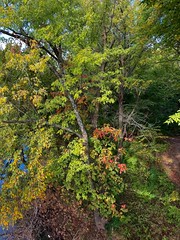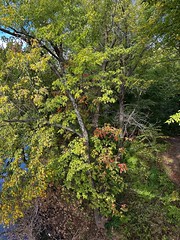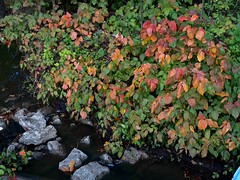July 2, 2014
We spent most of our fifth day directly along old Route 66 in Albuquerque before heading northeast in the afternoon to Santa Fe, with a stop at the ruins of the Kuaua Pueblo in Bernalillo along the way.
Stephen Hawking wrote that he limited himself to only one equation in his bestseller A Brief History of Time, since he was warned that each equation he included would halve book sales. (The physics teacher in me wonders if you can guess which equation he included, and also whispers, “So the number of equations is inversely proportional to book sales.”) I hope something similar doesn’t apply to maps in blog posts, because this post has several, since a sense of place is important to me in this travelogue.
A Day Along Route 66
Much of this day was spent along Central Avenue, the path of old Route 66 through Albuquerque from 1937 until the highway was decommissioned in 1985. But Central’s history dates back to the 1700s or earlier, when it was a dusty trail that evolved into the city’s major east-west street, which then was called Railroad Avenue. Back in the days before tuberculosis was driven back by antibiotics, some sufferers came to Albuquerque for the dry air, and in 1908 the Presbyterian Sanitorium was built. Although Railroad Avenue had been renamed Central Avenue by then, it came to be called TB Avenue locally. With TB brought under control, the sanitorium’s future was in doubt by the 1950s, but it evolved into the Presbyterian Hospital Center, the largest acute care center in the state and sits at the junction of Central and I-25 between downtown and the University of New Mexico.
Before 1937 there was a big kink in Route 66 which diverted it, travelling east to west, from Santa Rosa up to Santa Fe before returning to Albuquerque. That kink is why we can say we spent almost the entire vacation along Route 66, even though in 1937 the kink was straightened out and The Mother Road began to skip Santa Fe, cutting 107 miles off its length. That era brought many travelers along Central Avenue, and the typical motor courts, restaurants, and curio shops to serve them.
Several motor courts are still hanging in there, and we noticed them the day before when we drove several miles east of the Frontier Restaurant, looking for groceries and extending our search to enjoy more of the old route. Today we’d walk a bit along Central before lunch, then head a few miles east to the university district for lunch, then back west a few miles to the oldest part of Albuquerque.
Downtown District
Our day began in the downtown district on the streets around Hotel Andaluz. We intended to walk over a block or so to the Telephone Museum of New Mexico to satisfy my geeky curiosity. The museum says it is only open from 10 until 2 on Wednesdays and Fridays, so this Wednesday morning was our shot! But, sadly, it was shuttered. Perhaps the reconstruction of the street was to blame, but I like to think there is only one docent, an old grandmotherly switchboard operator, who has fallen asleep inside. If only she had posted her telephone number outside, we could have called and roused her.
So we had to content ourselves with examining the exterior of the KiMo Theatre, a Pueblo Deco movie house constructed in 1927 and designed by Carl Boller and George Williamson. The name was coined by Isleta Pueblo Governor Pablo Abeita, who won a prize of $50 for the name, a combination of two Tiwa words meaning “mountain lion” but liberally interpreted as “king of its kind”. Interestingly, the K should be soft, not hard, so it should be pronounced “him-o”.
Like so many inner city theaters, the place fell into ruin by the 1970s and was slated for demolition, but the city saved and restored it. Wendy and I enthused about the wonderful entrance, with every surface decorated. There was splendid tile work on the floor and walls, nice wall imagery, creative overhead plaster work, and custom doors inviting one in. This is the sort of attention to detail that really sells: don’t you just want to yank those doors open and peek inside? I wish a movie had been showing at the KiMo during our brief stay in Albuquerque so we could have seen the interior in person.
University District
Joe Falkner admitted he was jealous we got to follow his advice to eat at the Frontier Restaurant, and followed up with a recommendation for El Patio de Albuquerque, which is situated in an old house about a block away from the Frontier near the university in the Nob Hill neighborhood. Once again we were glad we followed his recommendation.
David Sandoval, a retired engineer and Vietnam War-era Marine, opened El Patio almost 40 years ago after living in Hollywood. His goal was simple: create a restaurant focused on local cuisine but with an environment that could remain edgy and cool so the place could transcend generations and withstand changes to the neighborhood. David is around 70 years old now, and his restaurant continues to thrive. I enjoyed my tacos and my sopapilla was great, while Wendy says her green chile chicken enchiladas were the best EVER. She stopped to take a photo after a few bites, so I believe her.
Old Town
After lunch we drove back along Central Avenue, past the Hotel Andaluz, to Old Town. My father took me here over 20 years ago, and, at the time, I was not very impressed. My impression was that it was hot, dusty, and old with lots of shops and little else. Well, it was hot on this visit with mostly shops, but it wasn’t dusty, and a nearby museum was modestly entertaining. Let’s face it, Albuquerque is no Santa Fe in regards to the historic district. But it was a worthwhile stop, especially since I made my big art purchase of the summer while I was there.
In 1706 a group of Spanish families settled in the spot, not far from the Rio Grande, organizing their new town in the traditional Spanish colonial way, with a central plaza anchored by a church. So it is reminiscent of the historic district of Santa Fe, with a plaza and gazebo, old church, shops, and nearby museums. Santa Fe’s plaza dates back to 1610 and boasts the Saint Francis Cathedral, which I’ve admired on previous visits to Santa Fe and was built between 1869 and 1886 on the site of an old adobe church. So Albuquerque’s adobe San Felipe de Neri church, which was built in 1793 after the original church collapsed in a rainy summer, is older and less pretentious. The interior is far less ornate than the Santa Fe cathedral. Outside the Santa Fe cathedral is a striking statue of Saint Kateri Tekakwitha, while Albuquerque’s church has the nearby remnant of a cottonwood tree into which a parishioner carved the image of the Virgin de Guadalupe back in 1970.
At the north end of Old Town is an equestrian statue of Don Francisco Cuervo y Valdés, who founded Albuquerque. The Christian Cross stirrups were a bit much, I must say.
Wendy and I strolled the shops, but I did not expect to buy anything. I have two expensive framed photographs in my living room from previous visits to Santa Fe, both the work of the very talented Amadeus Leitner. They are both of New Mexican scenery: one is a gorgeous, painterly take on Shiprock and the other a large panorama from Chimney Rock at Ghost Ranch. I wasn’t looking for another large photograph for this trip; in fact, I wasn’t even thinking about purchasing another art work. Until we passed Gallery 8.
Pillow Vase
In the display window was a pillow vase the staff said was by Diane Aragon of the Acoma Pueblo. I’m no fan of pottery, despite enjoying learning about Maria Martinez a day earlier, but was intrigued by this vase’s overall shape, partially serrated opening, the handle hole filled by a suspended spinnable carved ball (which is a distinguishing characteristic of her work), and most of all by the shading of the airbrushed glaze across the incised carving of an eagle kachina dancer, contrasting with the smooth but richly colored reverse. Diane and her husband Wilbert “Junior” Aragon are both full-bloods of my age, with Wilbert coming from the Acoma pueblo.
I tried to be casual as I strolled about the shop, conversing with the very friendly and helpful staff. But I couldn’t help returning to that particular pillow vase, knowing it would look splendid on the mantle above my fireplace, next to my glass “Roots and Wings” sculpture. I asked for Wendy’s preference between two different pillow vases, and she favored the same one I did, which is signed “Orion Aragon, Laguna Pueblo N.M.” That sealed the deal, and soon it was being carefully boxed up for me. It is now adorning my mantle as the third beautiful reminder of New Mexico which I see every day.
Albuquerque Museum of Art & History
After dropping off my bundle in the car, we walked over to the Albuquerque Museum of Art & History. Well, it is a little light on both counts, compared to what is on offer up in Santa Fe. Wendy and I were both surprised at the number of visitors roaming about, given the rather limited galleries. A Christo exhibit did not impress either of us at all, since his work is almost entirely large-scale, temporary landscape works. Another gallery had an exhibit about Vivian Vance, famous for playing Ethel Mertz, Lucille Ball’s sidekick on TV. Vivian was born near where I now live, up in Cherryvale, Kansas. She became interested in drama at the Independence, KS high school and rebelliously moved to Albuquerque to become an actress, including performing at the KiMo Theatre we had passed by earlier that day. Vivian’s youngest sister was sitting in the gallery talking to patrons, but I didn’t take the time to ask her about Vivian’s infamous feud with co-star Bill Frawley.
The outdoor sculpture garden was a bust. The only exterior works I liked weren’t in that garden: The Dancer, 1989 by Michael Naranjo, the beautiful stone used for the museum walls, and a decorated entryway into Old Town. But inside the museum’s galleries there were some paintings we liked.
Wendy liked Landscape – Velarde, New Mexico by Victor Higgins, Santa Fe by B.J.O. Nordfeldt, and Painting #231 by Ed Garman. I liked OU graduate John Fincher‘s “Revlon painting” of The Burning of Albuquerque with its very bold colors and unsettling plant in the foreground, creating a sense of tension. The coloration, clarity, and context of Ernest L. Blumenschein’s Star Road and White Sun made it a standout, with the younger Taos Pueblo Indian Star Road, in his non-traditional attire, seeming to eclipse the older White Sun, who introduced peyote to the pueblo in 1907. Blumenschein sold this and other “top notchers” to Albuquerque High School for less than a tenth of their value back in the 1940s to support the school’s principal and his efforts to create an art center.
The standout painting, however, full of modern and classic imagery and iconoclasm, was in the corridor of the museum. Patrick McGrath Muñiz filled his 2010 Disneyfication of a Hero with religious, artistic, and pop culture references. Part of his thinking is how we miss some of the iconography in old paintings due to cultural amnesia, so which references in his painting were known in the past and which will be recalled in the future? Wendy and I had a ball finding different references, from Bart Simpson to Bugs Bunny, from Teletubbies to the Death Star. There are references to the Pharos of Alexandria, the destruction of native cultures by imperial Spain, and there’s a cupid with a gun and a video game controller, his bottom obscured not by the traditional ribbon but by unrolling toilet paper. There is much more to see, and this is one painting worth viewing in your web browser at full resolution so you can tell that even the frame is actually painted symbolic figures.
“Disneyfication of a Hero” is one of my largest paintings at the moment. In this piece I have represented various mythic and historical characters in an anachronistic narrative. As the title suggests the painting is about cultural transformation. The term “disneyfication” implies a process by which an object, character, place, artwork or piece of literature is stripped from its original context and meaning and repackaged in a sanitized Disney-like version ready for mass consumption. The central figure is a representation of the classical hero Hercules. As the rat magician rises above a TV screen making a commanding gesture, our hero holds a hair wax removal cream on his left hand. Inspired in Renaissance tradition I created a composition that reflects on a procession of “trumps.” Just like in the Tarot cards and in many pagan and Christian festivities every character is followed by one of a higher rank or position. Behind the hero I have painted allegorical figures that represent Time, Conquest, Childhood, Promised Land, Fame, Fortune and Death. These allegorical figures are accompanied by small Disney-like characters and other consumer culture related icons. The group is about to encounter a fortunetelling gypsy sitting with three Tarot cards. On the background there are other parallel stories taking place. Diego De Landa, a 16th century Spanish archbishop burned countless Mayan scriptures, erasing Pre-Columbian history in the name of Christianity. When placed in the same painting the narratives connect with new meaning. The burning and destruction of books, of history in the past doesn’t seem so distant from our contemporary consumer oriented corporate evangelists.
-Patrick McGrath Muñiz
Kuaua Pueblo
It was time to head to Santa Fe up along I-25, although first we stopped by the Golden Crown Panaderia in downtown Albuquerque to get baked goods. We got “Blue Corn” biscochitos, New Mexico wedding cookies, a lemon empanada, and other treats.
We stopped along I-25 at Bernalillo to visit the Coronado Historic Site, which is more important for its ruins of the Kuaua Pueblo than because Coronado once camped near there. I had planned to use the Culture Passes I purchased in advance, but we arrived so late they just waved us in for free, urging us to look around while we still could.
The pueblo was inhabited by Tiwa-speaking farmers from about 1325 CE to about 1550 CE. Kuaua is a Tiwa word that means “evergreen”, and the Rio Grande and great views of the Sandia Mountains are found on the eastern edge of the site. There are low reconstructed walls from the 1930s showing the layout of the pueblo. It was warm: Wendy’s notes say, “Kivas, heat, murals, heat, Rio Grande, heat.”
The greatest discovery at Kuaua were murals, painted as frescoes over a period of about 75 years in the 15th Century. They were found in kivas and are some of the best examples of Pre-Columbian art ever found in North America. An eager intern led us through a display of them, cautioning us that we could not use flash. Sadly we were too late to climb down into a reconstructed kiva on the grounds where they display what the murals might have looked like centuries ago. The intern described what archaeologists once thought some images represented – ideas which have since been revised. That is a mark of good science: questioning and refining what you think.
Cool Santa Fe
We arrived in Santa Fe around dinnertime and checked into our casita where we would stay five nights. It was within easy walking distance of the plaza and only one block from the Railyard. We were tired and ready to eat, so we strolled through the cool air over to Tomasita’s at the Railyard. We were both giddy from the cool air after the heat of Kuaua Pueblo and being stuck for awhile in a traffic jam on I-25.
At Tomasita’s I had the same thing I had eaten there previously: blue corn chicken enchiladas. Wendy had tamales, which she proclaimed as the best EVER (today was the day for great food!), and she loved the green chile sauce. We had more delicious sopapillas to boot. There is a great story online from Georgia Maryol about how she met Tomasita and took the plunge in 1974 to run a cafe which they built the business into the thriving spot is it today.
We walked to the plaza, feeling the cool air and seeing clouds building to the northeast; the sky was like a painting. Low-riders were rumbling by the plaza, passing the shop windows of curios and artworks. A group was performing at the gazebo, and we listened and relaxed until droplets of rain warned us to return to our casita. We passed the old state capitol, beautifully lit under a swelling sky. A light shower descended, with Wendy using an umbrella and me charging along in my Tilley hat, arriving a bit wet but very happy at our little shelter.
The next day we’d venture out to Bandelier National Monument to hike along Frijoles Creek, which was closed by the Los Conchas fire when I first tried to hike there three years previously.





















